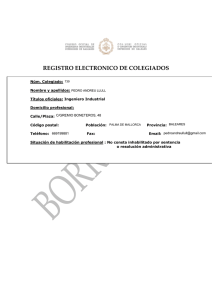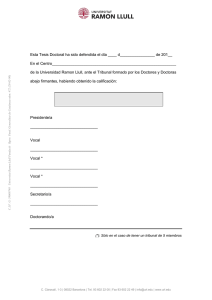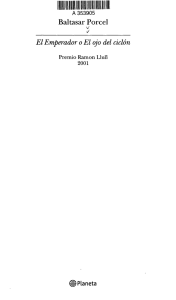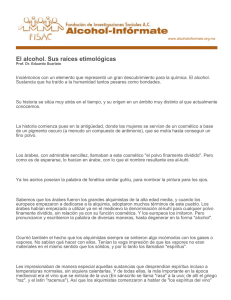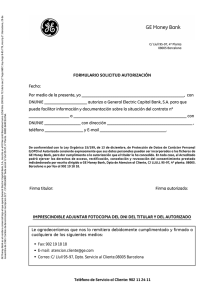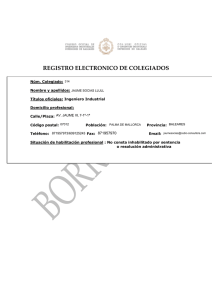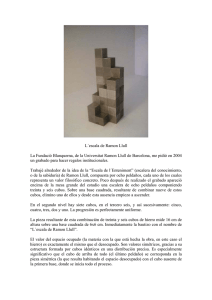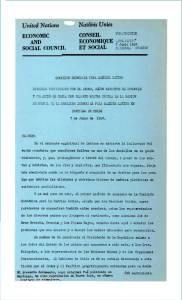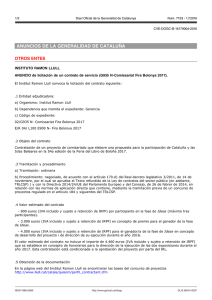Número 54
Anuncio
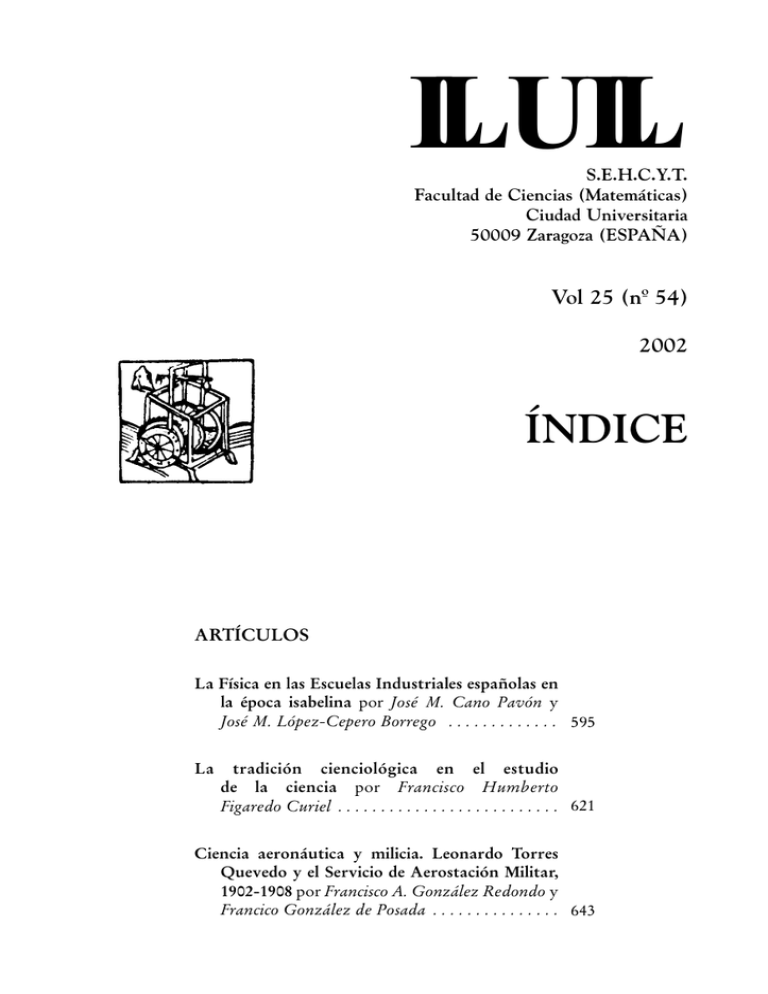
LLULL S.E.H.C.Y.T. Facultad de Ciencias (Matemáticas) Ciudad Universitaria 50009 Zaragoza (ESPAÑA) Vol 25 (nº 54) 2002 ÍNDICE ARTÍCULOS La Física en las Escuelas Industriales españolas en la época isabelina por José M. Cano Pavón y José M. López-Cepero Borrego . . . . . . . . . . . . . 595 La tradición cienciológica en el estudio de la ciencia por Francisco Humberto Figaredo Curiel . . . . . . . . . . . . . . . . . . . . . . . . . . 621 Ciencia aeronáutica y milicia. Leonardo Torres Quevedo y el Servicio de Aerostación Militar, 1902-1908 por Francisco A. González Redondo y Francico González de Posada . . . . . . . . . . . . . . . 643 Hierro y Carbón. Claves para una historia de la siderurgia en la Guayana venezolana por Juan José Martín Frechilla . . . . . . . . . . . . . . . . . . . . . . . . . . . . . . 677 La correspondencia científica entre Santiago Sánchez Cózar y Emilio Huguet del Villar (1946-1949): La investigación botánica y edafológica en el norte de África en la época del protectorado hispano-francés por José María Núñez Espallargas . . . . . . . . . . . . . . . 715 El ingeniero e inventor Enrique Hauser y Neuburger (1866-1938): Apuntes biográficos por Octavio Puche Riart . . . . . . . . . . . . . . . . . . . . . . . . . . . . . . . . . . . . . . . 795 Sobre la inconmensurabilidad de las teorías: Un caso histórico a debate por Rafael Rodríguez Sánchez . . . 813 NOTAS Los premios Nobel 2002 de Química (Fenn, Tanaka y Wüthrich) y Física (Davis, Giacconni y Koshiba) por Manuel Castillo Martos . . . . . . . . . . . . . . . . . . . . 829 Tesis doctoral de Filosofía de la Ciencia en la Universidad de Oviedo por Jorge Ordaz . . . . . . . . . 834 RESEÑAS Cajal, Ochoa. Nóbeles españoles. De la neurona al ADN por Francisco Herrera Rodríguez . . . . . . . . . . 837 Sobre sólida roca fundada: Ciento veinte años de labor docente, asistencial e investigadora en la Facultad de Medicina de Granada (1857-1976) por Francisco Herrera Rodríguez . . . . . . . . . . . . . . . . . . . . . . . . . . . 839 História da Farmácia por Juan Riera Palmero . . . . . . . 842 Història del Reial Col.legi de Cirurgia de Barcelona (1760-1842) por Juan Riera Palmero . . . . . . . . . . . . . 843 Los señores del fuego. Destiladores y espagíricos en la corte de los Austrias por Juan Riera Palmero . . . . . . 844 El fin de los mitos geológicos: Lyell por Leandro Sequeiros . . . . . . . . . . . . . . . . . . . . . . . . . . . . . . . . . . . 846 Médicos, Donjuanes y mujeres modernas. Los ideales de feminidad y masculinidad en el primer tercio del siglo XX por Josep Lluís Barona . . . . . . . . . . . . . . . . 847 Antonio José Cavanilles (1754-1804). La pasión por la Ciencia por Raúl Rodríguez Nozal . . . . . . . . . . . . . . 849 Evolucionismo y Cultura. Darwinismo en Europa e Iberoamérica por Francisco Teixidó Gómez . . . . . . . 852 Los elixires de la Ciencia. Miradas de soslayo en poesía y prosa por Francisco Teixidó Gómez . . . . . . . . . . . . . 853 Adán y Darwin por Francisco Teixidó Gómez . . . . . . . . 856 Molinos de marea de la Bahía de Cádiz (Siglos XIVXIX) por Enrique Wulf Barreiro . . . . . . . . . . . . . . . . . 860 One and a Half Centuries of Sea and Fisheries Investigations in Estonia por Enrique Wulff Barreiro . . . . . . . . . . . . . . . . . . . . . . . . . . . . . . . . . . . 861 NOTICIAS España . . . . . . . . . . . . . . . . . . . . . . . . . . . . . . . . . . . . . . . . 867 Latinoamérica . . . . . . . . . . . . . . . . . . . . . . . . . . . . . . . . . 877 Anuncios . . . . . . . . . . . . . . . . . . . . . . . . . . . . . . . . . . . . . . 879 Cursos y Seminarios . . . . . . . . . . . . . . . . . . . . . . . . 882 Reuniones Celebradas . . . . . . . . . . . . . . . . . . . . . . . 883 AUTORES . . . . . . . . . . . . . . . . . . . . . . . . . . . . . . . . . . . 885 INFORMACIÓN Y NORMAS PARA AUTORES . . . . . . . . . . . . . . . . . . . . . . . . . . . . . . . 889 CONTENTS . . . . . . . . . . . . . . . . . . . . . . . . . . . . . . . . . 893 LLULL, vol. 25, 2002, 595-620 LA FÍSICA EN LAS ESCUELAS INDUSTRIALES ESPAÑOLAS EN LA ÉPOCA ISABELINA (1850-1868) JOSÉ M. CANO PAVÓN Universidad de Málaga JOSÉ M. LÓPEZ-CEPERO BORREGO Universidad de Sevilla RESUMEN ABSTRACT La Física tuvo en las escuelas industriales que funcionaron en España durante el reinado de Isabel II y especialmente a partir de 1850, una importancia bastante grande, al ser imprescindible para aquellos alumnos que cursaban la especialidad mecánica. Su importancia, medida por el número de profesores, el número de asignaturas, las horas lectivas y los instrumentos disponibles en los gabinetes, fue mayor que en las facultades de ciencias en ese periodo. Physics was quite prominent in Spanish industrial schools during the reign of Isabel II, and specially after 1850, when it became indispensable for students majoring in mechanics. Its significance, reflected in the number of teachers, subjects, lecture hours and instruments available at cabinets, exceeded that in the science faculties of the time. En general, la enseñanza de la Física en estas escuelas para aquellos alumnos que cursaban los estudios de ingeniería superior comprendía un curso de carácter básico y dos cursos de Física industrial, asignaturas necesarias para poder abordar el estudio de aquellas otras de mayor carácter tecnológico, como la Mecánica industrial y la Construcción de máquinas. Para aquellos que cursaban sólo el nivel elemental, la enseñanza se limitaba al estudio de los Recibido el 23 de diciembre de 2002 As a rule, the Physics curriculum for higher engineering students at such schools encompassed a basic year and two Industrial Physics ones; the corresponding subjects constituted a prerequisite for addressing other, more technology-oriented studies such as Industrial Mechanics and Machine Construction. For those doing the elementary level, however, the curriculum was restricted to the fundamental principles and industrial applications of Mechanics. I.S.S.N. 0210-8615 596 JOSÉ MANUEL CANO PAVÓN y JOSÉ MANUEL LÓPEZ-CEPERO BORREGO principios más generales de la Mecánica y sus aplicaciones industriales. En el presente artículo se realiza un estudio detallado sobre la enseñanza de la Física en las escuelas industriales en este periodo, considerando al profesorado, los programas, los libros utilizados y las características generales de los gabinetes de los distintos centros. También se abordan otros aspectos no docentes, haciendo hincapié en la contribución de estas escuelas a la difusión de las nuevas tecnologías, especialmente las experiencias de alumbrado eléctrico en las ciudades usando corrientes continuas. LLULL, 25 This paper presents a comprehensive study of the teaching of Physics at industrial schools in the above-mentioned period. It deals with teachers, curricula, books and the characteristics of the cabinets in the different institutions. The paper is also concerned with other, non-teaching aspects, with especial emphasis on the role played by the schools in spreading the new technologies (e.g., the implementation in Spanish cities of electrical ligthing based on direct current). Palabras clave: Física, Enseñanza de la Física, Enseñanza Industrial, Escuelas Industriales, Instituciones, Siglo XIX, España. LLULL, vol. 25, 2002, 621-642 LA TRADICIÓN CIENCIOLÓGICA EN EL ESTUDIO DE LA CIENCIA FRANCISCO HUMBERTO FIGAREDO CURIEL Universidad de Camagüey, Cuba RESUMEN ABSTRACT Los estudios sociales de ciencia-tecnología-sociedad no reconocen en su justa medida la contribución de otras tradiciones de pensamiento social al estudio de la ciencia y la tecnología. Sin embargo, en el ex-campo socialista fue publicada a mediados de la década de los 80 del siglo XX una obra de carácter interdisciplinario que ofrece una caracterización general de la ciencia que debe ser estudiada y difundida. The social studies of science-technology-society, do not recognize the contribution other traditions of social thought studies of science and technology. Nevertheless, in the former socialist field appeared during the middle 1980´s a reference work, as result of an international project with an interdisciplinary character, giving a general feature of science, which should be studied. Palabras Clave: Marxismo, Proyecto cienciológico, Tradiciones en el estudio social de la ciencia y la tecnología, Interdisciplinariedad, Siglo XX. Recibido el 9 de abril de 2002 I.S.S.N. 0210-8615 LLULL, vol. 25, 2002, 643-676 CIENCIA AERONÁUTICA Y MILICIA. LEONARDO TORRES QUEVEDO Y EL SERVICIO DE AEROSTACIÓN MILITAR, 1902-1908 FRANCISCO A. GONZÁLEZ REDONDO Universidad Complutense de Madrid FRANCISCO GONZÁLEZ DE POSADA Universidad Politécnica de Madrid RESUMEN ABSTRACT En 1901 Leonardo Torres Quevedo, ingeniero de caminos español consagrado en el mundo científico europeo con sus máquinas algébricas, pasa a dedicarse al desarrollo de un nuevo sistema de dirigibles de su invención. En esos momentos en España solamente se realizaban experiencias con globos aerostáticos —no dirigibles— en el Servicio de Aerostación Militar. Ambos mundos se encontrarán en 1902 y convivirán hasta 1908. In 1901 the Spanish civil engineer Leonardo Torres Quevedo had reached a very high consideration in the European scientific community through his algebraic machines. But from that moment on he devoted himself to the development of a new system of dirigible balloons of his own invention. In those days in Spain aeronautical experiences were carried out only with —non-dirigible— balloons by the Army’s Aerostatic Service. Both two worlds will meet in 1902 and live together until 1908. Con este marco, en este trabajo se documentan y analizan las relaciones de Torres Quevedo con los aerosteros militares: durante todo ese período con el Jefe del Servicio, Pedro Vives; entre 1905 y 1908 con el principal colaborador de D. Leonardo, el ingeniero militar Alfredo Kindelán. De este modo, por primera vez se realiza la clarificación de unos encuentros y desencuentros entre los pioneros de Recibido el 14 de mayo de 2002 In this paper the relationships between Torres Quevedo and military aeronauts are documented and analysed: along the whole period with Pedro Vives, the Chief of the Service; between 1905 and 1908 with Alfredo Kindelán, D. Leonardo’s main assistant. Consequently, for the first time the encounters and ruptures between I.S.S.N. 0210-8615 644 FRANCISCO A. GONZÁLEZ REDONDO & FRANCISCO GONZÁLEZ DE POSADA la Aeronáutica española que hasta hoy la historiografía oficial no había querido o no había podido efectuar. LLULL, 25 the pioneers of Spanish Aeronautics are clarified in a manner that official historiography could not or didn’t want to fulfil until now. Palabras clave: L. Torres Quevedo, Ejército, Aeronáutica, Ciencia y Sociedad, Siglo XX, España. LLULL, vol. 25, 2002, 677-714 HIERRO Y CARBÓN. CLAVES PARA UNA HISTORIA DE LA SIDERURGIA EN LA GUAYANA VENEZOLANA: 1946-1957 JUAN JOSÉ MARTÍN FRECHILLA Universidad Central de Venezuela RESUMEN ABSTRACT La historia del hierro y del acero en la Guayana venezolana al final de la década de los años cincuenta, es una parte de la historia del país que es necesario articular con la historia social de la ciencia y la tecnología. El artículo tiene el propósito de presentar las claves —acontecimientos, instituciones, personajes, localización de reservas, políticas de Estado— necesarias para emprender un estudio histórico de esta naturaleza a fin de ensayar después su consistencia en una reconstrucción cronológica apoyada en documentación original, y en buena parte inédita. The history of the iron and steel industry in Guayana (Venezuela) in the late 1950s belongs to the overall history of the country, but it is appropriate to take into consideration aspects related to the history of science and technology, especially in the social dimension. The aim of this article is to suggest the appropriate paths for carrying out a historical study of this nature, with a view to later proving its relevancy to a chronological reconstruction based on wider documentary support. Palabras clave: Industrialización, Transferencia Tecnológica, Técnica, Latinoamérica, Siglo XX. Recibido el 30 de noviembre de 2002 I.S.S.N. 0210-8615 LLULL, vol. 25, 2002, 715-794 LA CORRESPONDENCIA CIENTÍFICA ENTRE SANTIAGO SÁNCHEZ CÓZAR Y EMILIO HUGUET DEL VILLAR (1946-1949): LA INVESTIGACIÓN BOTÁNICA Y EDAFOLÓGICA EN EL NORTE DE ÁFRICA EN LA ÉPOCA DEL PROTECTORADO HISPANO-FRANCÉS JOSÉ M. NÚÑEZ ESPALLARGAS Universidad de Barcelona RESUMEN Se reúne la correspondencia mantenida entre Santiago Sánchez Cózar, Ingeniero Jefe de Montes del Protectorado Español en Marruecos, y el científico Emilio Huguet del Villar que, desde Rabat, realizaba diversos estudios edafológicos para las autoridades coloniales francesas. El epistolario contiene 62 cartas de la correspondencia científica intercambiada entre ambos durante los años 1946 a 1949. Este material aporta importante información, no sólo sobre las investigaciones que individualmente o en colaboración llevaban a cabo los dos autores, sino también sobre el entorno en que éstas tenían lugar, el Protectorado conjunto Hispano-francés sobre Marruecos, y en una época difícil para ambas naciones recién acabadas la Guerra Civil española y la Segunda Guerra Mundial. Recibido el 17 de octubre de 2002 ABSTRACT This paper collects the correspondence between Santiago Sánchez Cózar, chief forestry engineer under the Spanish Protectorate in Morocco, and the Spanish scientist Emilio Huguet del Villar, who made several edafological researches in Northen Africa at the French colonial authorities service. The collection of letters includes 62 letters from the years 1946 to 1949. This documents contain important information, not only about the individual or joint investigations of both scientists, but also on the political, economic and social environment conditions which affected their activity, just at the end of the Spanish Civil War and the Second World War. I.S.S.N. 0210-8615 716 JOSÉ M. NÚÑEZ ESPALLARGAS LLULL, 25 Palabras Clave: Emilio Huguet del Villar, Santiago Sánchez Cózar, Botánica, Edafología, Marruecos, Correspondencia, Siglo XX. LLULL, vol. 25, 2002, 795-812 EL INGENIERO E INVENTOR ENRIQUE HAUSER Y NEUBURGER (1866-1938): APUNTES BIOGRÁFICOS OCTAVIO PUCHE RIART Universidad Politécnica de Madrid RESUMEN ABSTRACT El ingeniero español Enrique Hauser y Neuburger (Gibraltar, 1866-París, 1938) es una de las figuras científicas más desconcocidas desde el punto de vista histórico, a pesar de los múltiples cargos académicos que desempeñó y de sus diferentes inventos. The Spanish engineer Enrique Hauser y Neuburger (Gibraltar, 1866-Paris, 1938) is one of the most unknown scientists from a historical point of view in spite of the multiple academic functions he carried out and his many different inventions. En este artículo se presenta una visión general de la vida del ingeniero Enrique Hauser y Neuburger, profesor del Laboratorio de Química de la Escuela Especial de Ingenieros de Minas de Madrid. A general overview of the life of Enrique Hauser y Neuburger, a professor of the Chemical Laboratory at the School of Mines (Madrid), is shown in this article. Palabras clave: Ingeniería de Minas, Ingeniería Eléctrica, Gases Combustibles, Grisú, Físico-Química, patentes, Enrique Hauser, España, siglos XIX y XX. Recibido el 30 de noviembre de 2002 I.S.S.N. 0210-8615 LLULL, vol. 25, 2002, 813-828 SOBRE LA INCONMENSURABILIDAD DE LAS TEORÍAS: UN CASO HISTÓRICO A DEBATE RAFAEL ÁNGEL RODRÍGUEZ SÁNCHEZ C.E.S. «Cardenal Spínola CEU»,Universidad de Sevilla RESUMEN ABSTRACT Este artículo parte del concepto de inconmensurabilidad para realizar un estudio descriptivo sobre la medicina en la revolución científica española. Se analizan, a través de una serie de textos de la España del momento, los argumentos a favor y en contra que manejaban la medicina galenista y la moderna respecto a cinco puntos: la digestión de los alimentos, la circulación de la sangre, el uso de la sangría y la administración de la quina y el antimonio como antipiréticos. Al hilo de estos temas se pone de manifiesto cómo cada teoría trataba de imponer su perspectiva y lenguaje propios, dificultándose el diálogo entre ambas. This paper uses inconmensurability to make a descriptive study on medicine in the Spanish scientific revolution. We analyze, through a series of Spanish documents of the moment, positive and negative arguments which galenist and modern medicine used with regard to five questions: food digestion, circulation of the blood, use of bleeding and the administration of quinine and antimony as temperature-lowering drugs. We try to show how each theory pretended to impose its own perspective and language and how dialogue became quite difficult between them. Palabras Clave: Filosofía moderna, Ciencia moderna, Siglos XVII - XVIII, España, Revolución científica, Medicina galenista, Medicina moderna. Recibido el 4 de junio de 2001 I.S.S.N. 0210-8615
